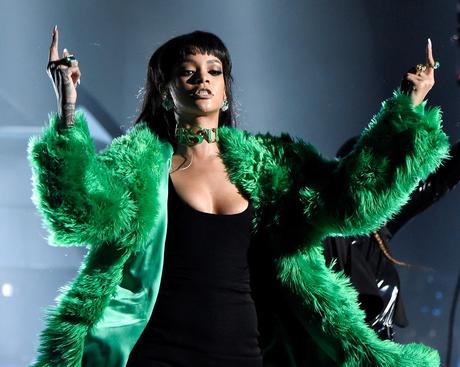
Rihanna performing BBHMM live at the 2015 iHeart Radio Music Awards.
As anyone even mildly interested in pop culture likely knows, Rihanna recently dropped a new music video for her song Bitch Better Have My Money. I found the video itself interesting, but honestly found the critiques of it even more so. Many of these critiques demonstrate that mainstream culture still doesn’t know how to meaningfully engage with black women and the popularity of the work they create. Specifically, it seems that critics of black, female artists try to understand their work through the lens of static theories that reiterate racist tropes, and which produce prescriptive, limiting understandings of their work. We’ve seen this with panic over Beyoncé’s feminism, shock in response to Nicki Minaj’s Anaconda album cover, and now rejection of the violence and nudity in BBHMM.
To be sure, Rihanna’s video is violent. She kidnaps, terrorizes another woman, murders and ends up covered in blood. But while this violence is shocking and even disturbing, it arguably makes a bold statement in an era where white people continue to violently violate black women’s bodies. Considering that we live in a world in which white men still cite protecting white women as justification for murdering black people — as the Charleston shooter recently did when he shot black folks in a church — Rihanna’s desecration of white women’s mythological fragility is poetic, symbolic, and powerful. The image of a sexualized, white woman hanging from a rope — a symbol that conjures historical images of racial terrorism through lynching — serves as a powerful rupture in the narrative of black victimhood at the hands of white folks. Rihanna turns this narrative on its head and offers a new depiction of resistance that deserves thoughtful analysis.
And yet many critiques of this video have been anything but complex. Plenty of critics have lazily compared Rihanna to other white, male artists or masculine tropes more generally. For example, one critique compared her video to Quentin Tarantino’s work, while another posited that she is “re-packaging” toxic, patriarchal ideas. The white, topless woman hanging upside down from a rope has been interpreted as catering to our culture’s misogynistic desire to see women humiliated and violated — an all too common trope in men’s films.
These analyses — rooted in the white, male gaze — effectively erase Rihanna’s attempt to create her own narrative and reveal our culture’s more general anxiety about black women’s imagination, creativity and autonomy. Because Rihanna is engaging with topics traditionally coded male — like sexualization and violence — critics have deferred to white men’s work to understand it and assumed that she’s automatically capitulating to the patriarchy. The assumption here is that female artists can’t critically engage with these topics just because men have previously exploited them. By suggesting that women can only “re-brand” or re-purpose work originally created by men, men are positioned as experts and innovators and women their imitators. Women are stripped of their subjectivity and a landscape inhospitable for women’s authentic self-expression is created.
To be clear, I’m not suggesting that Rihanna is impervious to sexism or misogyny. But I don’t think she is emulating white men’s violence or attempting to titillate the male gaze, either. I think she is trying to occupy a middle ground, to carve out a visual space where she can engage in a representation of her justified rage. We should honor this attempt by taking our time to understand her work, even if that means looking beyond pre-existing theories influenced by the patriarchy and male gaze to understand it. We owe Rihanna and all other black, female artists the dignity of taking their work seriously and analyzing it in a way that accommodates them and their experiences.

